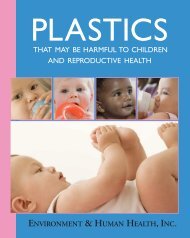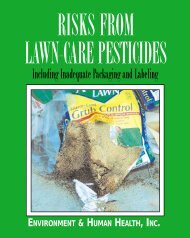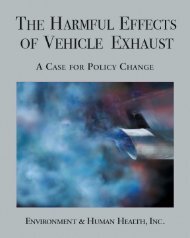LEED Report - Environment & Human Health, Inc.
LEED Report - Environment & Human Health, Inc.
LEED Report - Environment & Human Health, Inc.
- No tags were found...
Create successful ePaper yourself
Turn your PDF publications into a flip-book with our unique Google optimized e-Paper software.
The Green Building DebatePoints may be awarded in other subcategories, including daylight andviews, thermal comfort, lighting, air delivery monitoring, ventilation,chemical and pollutant source control, and material emissions.Chemical and pollutant source control and materials emissions areperhaps most relevant to human health among all the criteria considered,yet collectively account for a very small percentage of the total scoreawarded to a project. A building may receive “platinum,” or the highestranking in the <strong>LEED</strong> system, without any points being awarded in thecategory intended to protect human health (Appendix I).During the last half-century, society’s growing exposure to chemicalshas been accompanied by an increase in the prevalence of manyillnesses and conditions. These include respiratory diseases, childhoodasthma, neurological impairments, declining sperm counts, fertilityfailure, increase in autoimmune disease and severe allergies, breastand prostate cancers, and developmental disorders among the young.Some of these problems have been caused or exacerbated by exposureto commercial chemicals and pollutants. 4 There is little doubt, forexample, that tobacco, lead, mercury, radionuclides, solvents, vehicleexhaust, combustion by-products, dioxins, PCBs and many pesticideshave caused extensive human illness.Greater insulation, lessventilation, and a hugeincrease in new chemicalsand products, within newbuildings, collectively inducechemical exposures andthreats to health neverpreviously experiencedin human history.The rise in childhood asthma, beginning in the early 1980s, hasparalleled an increase in energy efficiency of buildings, and datasuggest that increased chemical exposure in indoor environments maybe the reason. Greater insulation, less ventilation, and a huge increase innew chemicals and products, within new buildings, collectively inducechemical exposures and potential health effects never previouslyexperienced in human history.<strong>LEED</strong> building certification standards that insufficiently account forthreats to human health are being adopted or encouraged by many U.S.laws and regulations. A rapidly growing number of federal, state, andlocal laws and regulations are adopting <strong>LEED</strong> standards that affectbuilding codes and zoning and subdivision regulations.9







